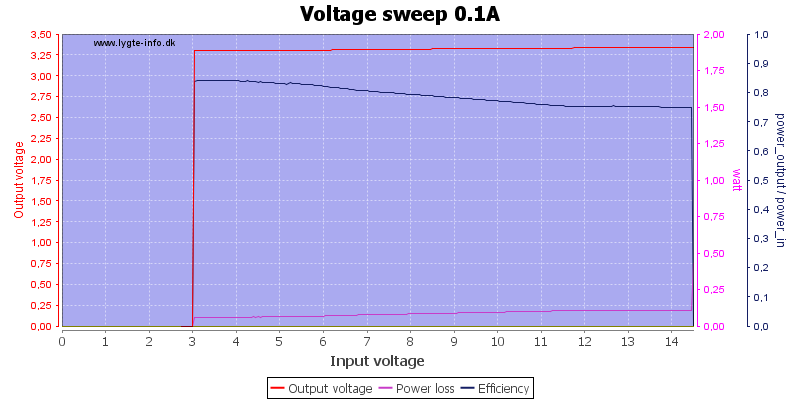DC-DC Step updown 2.5V-15V to 3.3V

Official specifications:
- Input voltage: 2.5 v-15 v
- Output voltage: 3.3v/5v(optional)
- Output current: 0.6A
- Conversion efficiency: 75%
- Output ripple: <50mV
- Output accuracy: + -0.1 v
- Working temperature: -20- + 85 centigrade
- Relative humidity: 20-90%
- Size: 19 * 14 * 4mm
- Pcb thickness: 1.2mm
- PCB layers: 2 layers
- Power control: with cut off
- Cooling method: cooling nature
- Installation method: SMD or 2.54mm pin
- Production process: reflow
- Isolated: no
- Design aging standards: 720 hours without problems
- Production factory aging standards: 48 hours
- Lifetime: 35000 hours without problems
- Factory inspection standards 3 times: all (factory / aging / out of library test)
- Fixed switching frequency: 1200 khz
I got it from Ebay dealer: memolines


Measurements
This chapter only contains a few of the measurement, click here to see all
- Power consumption when unloaded is up to 0.25mA
- For the module to work the EN pin must be pulled high, I connected it directly to + input.
- Enable input has 300kOhm series resistor on the circuit board and after that a 100kOhm pull down resistor.
- Module size: 18.7 x 13.7 4.5mm

The lowest input voltage the converter will work at is 3.1V, at 3V it do not work. This may be related to the enable pin.

Increasing the input voltage to 4V changes the efficiency a bit at higher currents.

At 12V input the efficiency is higher at high current and lower at low current.


It works nicely with input voltage from 3.1V up to 14.5V with a 100mA load.

At higher current the efficiency is fairly low with low input voltage.

Power consumption varies with input voltage, it looks like the boost converter may kick in at slightly above 5V.

With a fairly low load the output noise is low.

But increase the load and the noise will increase, this could probably be fixed with som capacitors.

Increasing the input voltage will reduce the noise.


Turning power on off works fine with load, at higher load there may be some oscillations during turn-on/off.

Turning on a load is handled with a minimal voltage drop.

But at higher load there may be oscillations and some input and output capacitors is needed.

The voltage will increase when a load is removed.

I did the load test at 0.5A with 3.5V input, this was handled nicely.

M1: 61.4°C, M2: 66.6°C, M3: 66.1°C, M4: 59.9°C, HS1: 76.0°C
The converter is warm, but not too warm, this means it can handle about 1W power loss.

Increasing the input voltage to 9V and increasing the current to 0.6A do not present any problems.

M1: 58.4°C, M2: 53.9°C, M3: 50.8°C, HS1: 61.3°C
Now the converter is in buck mode and the other inductor heats up, generally everything is a bit cooler here.
Closer look

The module only uses a 6 pin chip. The output inductor is capacitive coupled to the input inductor and the chip only controls the input inductor.





Good markings on the back.

Conclusion
The module is not very powerful, but can be used to supply a 3.3V circuit from a LiIon battery, especially if it is fairly low power. I would use some extra capacitors with the module.
Notes




























